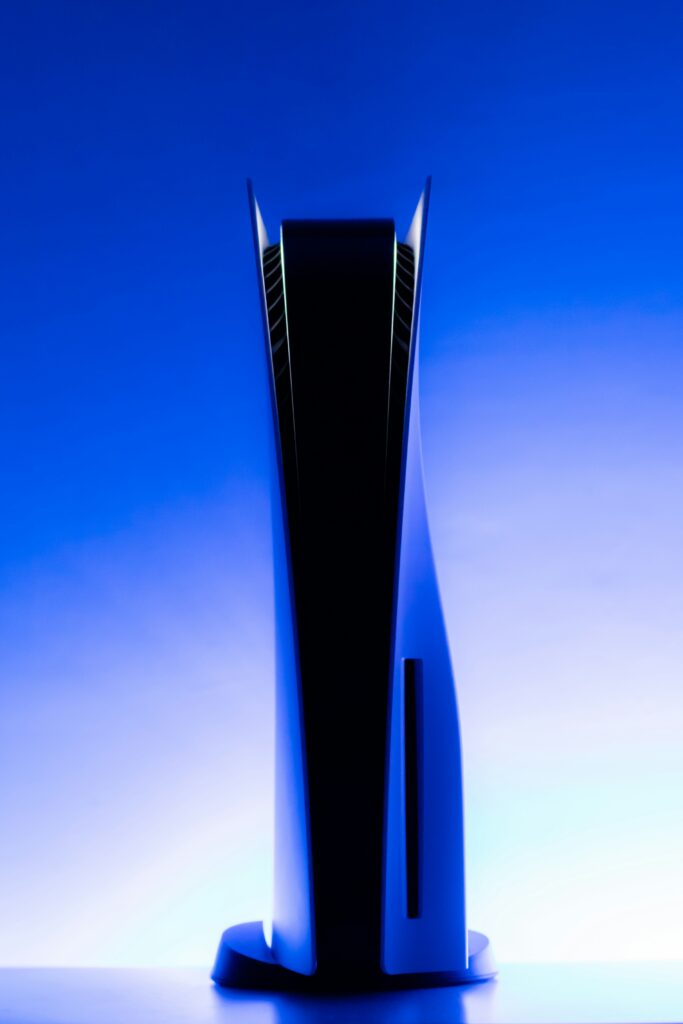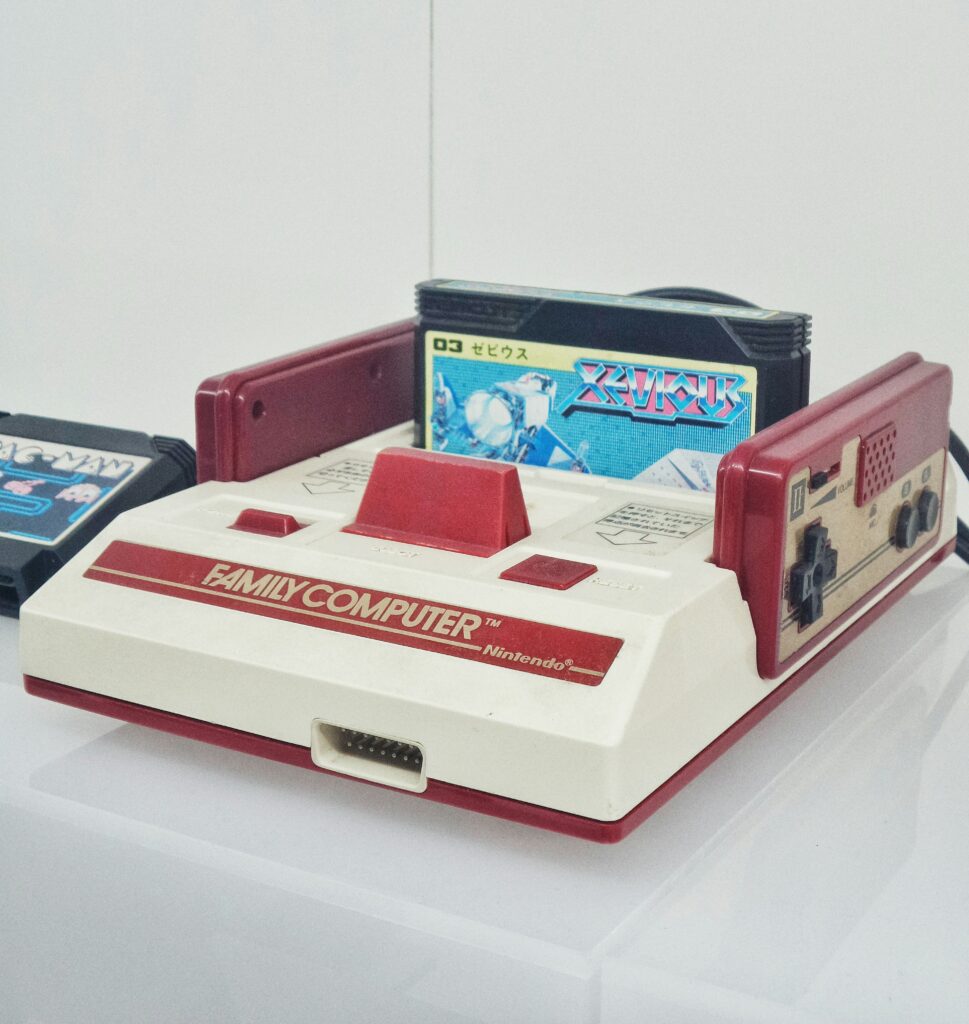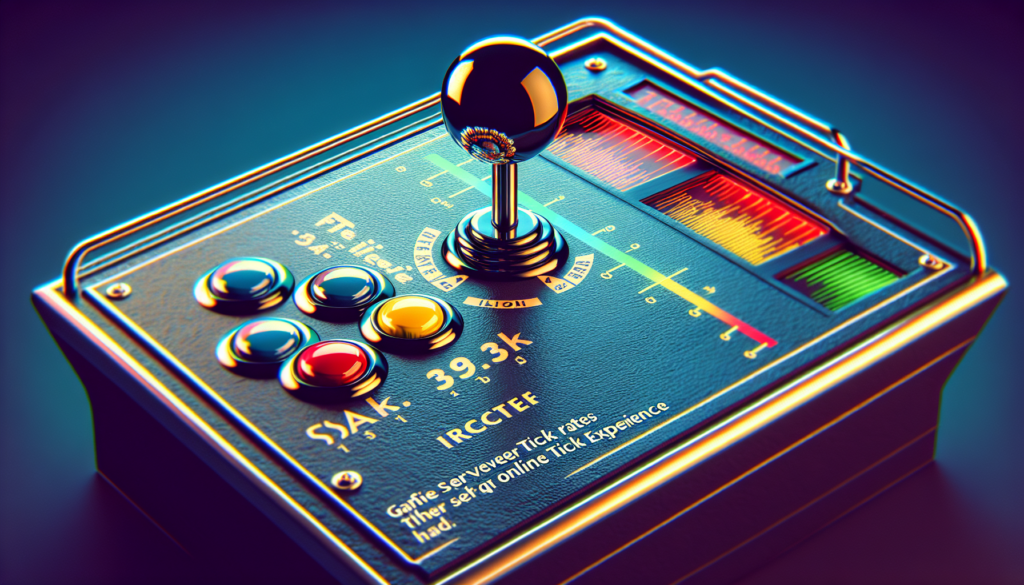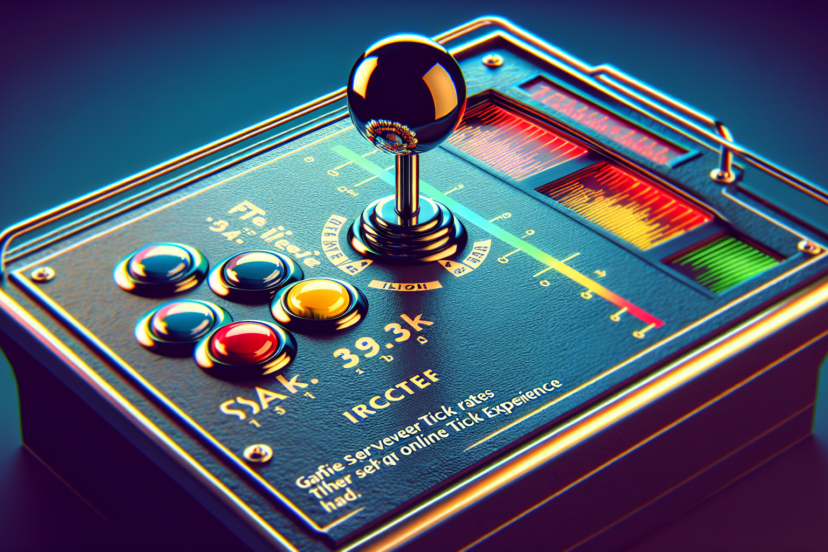What Is A Gaming Server Tick Rate?
Imagine this: you’re in the middle of an intense online gaming session with your friends, strategizing and battling it out in a virtual world. Suddenly, your character freezes for a split second, and just like that, you lose the upper hand. Frustrating, isn’t it? Well, that split second pause can be attributed to something called a gaming server tick rate. But what exactly is it? In simple terms, the tick rate is the number of times per second the game server updates the game state and sends that information to your computer. A higher tick rate means more frequent updates, resulting in smoother gameplay and reduced lag. So, join us as we explore the fascinating world of gaming server tick rates and how they affect our gaming experiences.
Understanding the Basics of Gaming Server Tick Rate
Definition of Gaming Server Tick Rate
Gaming server tick rate refers to the number of times per second that the server updates the game state and sends information to connected players. It is measured in “ticks,” with each tick representing a single update. The tick rate determines how frequently the server processes and transmits data, such as player movements, actions, and interactions with the game world.
Importance of Tick Rate in Online Gaming
Tick rate plays a crucial role in online gaming as it directly affects the responsiveness and smoothness of gameplay. A higher tick rate means the server updates more frequently, reducing the delay between player actions and the game’s reaction. This leads to a more fluid and immersive gaming experience, particularly in fast-paced games where split-second decisions can determine the outcome.
How Tick Rate Affects Gameplay Experience
The tick rate heavily influences the gameplay experience by determining how accurately the server can represent the game state for each player. A lower tick rate may result in delayed reactions to actions, instances of rubber-banding or teleportation, and inconsistencies in hit detection. On the other hand, a higher tick rate provides more responsiveness, accurately reflecting player movements and interactions, enhancing overall gameplay quality.
Difference between Tick Rate and Frame Rate
It’s important to note that tick rate and frame rate are two distinct concepts. Tick rate refers to the server’s frequency of updates, while frame rate represents the number of frames displayed per second on a player’s screen. Tick rate affects the synchronization between players and the server, while frame rate impacts the smoothness and visual quality of the game. Both are crucial factors in delivering an optimal gaming experience.
Factors Affecting Tick Rate
Several factors influence the tick rate of a gaming server. The server’s computational power and bandwidth determine its capacity to process and transmit data. The number of players connected to the server also affects the tick rate, as the server must handle the load of updating and communicating with each individual. Additionally, network conditions, such as latency and packet loss, can impact the tick rate by introducing delays or data inconsistencies during transmission.
Determining Tick Rate in Different Games
Default Tick Rate
Each game typically has a default tick rate set by its developers, which serves as the baseline for gameplay. This default tick rate is chosen based on various factors, including the game’s design, network requirements, and hardware limitations. While the default tick rate provides a standard experience, it may not always be optimal for all players or game modes.
Varied Tick Rates in Different Game Modes
Some games feature different tick rates for various game modes. For example, a first-person shooter may have a higher tick rate in competitive modes to ensure precise hit detection and responsiveness, while offering a lower tick rate in casual modes to accommodate larger player counts and minimize server load. This allows developers to strike a balance between performance and gameplay experience in different scenarios.
Customizable Tick Rates in Some Games
In certain games, players are given the option to customize the tick rate for their preferred multiplayer experience. This flexibility allows players to adjust the tick rate based on their individual preferences and hardware capabilities. However, it’s important to consider that increasing the tick rate beyond what the server or network can handle may result in degraded performance or connection issues for both the player and other participants.
Importance of Consistent Tick Rate
Regardless of the chosen tick rate for a game or game mode, maintaining a consistent tick rate is crucial to ensure fair and consistent gameplay for all players. Fluctuating tick rates can introduce unpredictable variations in the game state, leading to inconsistencies in player interactions and potentially giving certain individuals advantages or disadvantages. Developers must strive for stability and reliability in maintaining a consistent tick rate throughout gameplay.

Advantages and Disadvantages of Higher Tick Rates
Advantages of Higher Tick Rates
A higher tick rate offers several advantages in online gaming. Firstly, it improves the accuracy of hit detection and collision physics, making interactions between players and the game environment feel more precise and authentic. Additionally, a higher tick rate reduces the occurrence of “peeker’s advantage,” where a player with a lower latency gains an advantage by seeing opponents before they can react. Lastly, a higher tick rate enhances the overall responsiveness and fluidity of gameplay, leading to a more enjoyable experience for competitive and casual players alike.
Disadvantages of Higher Tick Rates
While higher tick rates provide numerous benefits, they also come with certain drawbacks. Firstly, a higher tick rate requires more computational power and bandwidth from the server, potentially increasing costs and straining server resources. Secondly, maintaining a consistently high tick rate may pose challenges for players with weaker internet connections, resulting in increased latency and potential gameplay disruptions. Lastly, setting an excessively high tick rate can create compatibility issues, limiting the number of players who can effectively connect to a server.
Balancing Performance and Tick Rate
Finding the right balance between performance and tick rate is essential for developers. They must consider the game’s technical requirements, target player base, and available server resources while striving to provide an optimal gaming experience. By carefully managing tick rates and implementing efficient network optimizations, developers can strike a balance that ensures smooth gameplay while minimizing performance limitations.
Evaluating Network and Server Performance
Measuring Tick Rate
Tick rate can be measured by monitoring the time it takes for the server to update and transmit game data to connected players. Server administrators can use performance monitoring tools to measure tick rate and identify any fluctuations or inconsistencies. Measuring tick rate is essential for evaluating server performance and identifying areas for improvement.
Relationship between Tick Rate and Ping/Latency
The ping or latency between a player and the server directly affects the tick rate they experience. Ping refers to the time it takes for data packets to travel from a player’s device to the server and back. A higher ping can introduce delays in receiving updates from the server, potentially affecting the responsiveness of gameplay. To achieve optimal tick rates, players should strive for low latency connections and choose servers closest to their physical location.
Server Tick Rate vs. Client Tick Rate
It’s important to differentiate between server tick rate and client tick rate. The server tick rate determines how often the server updates the game state and communicates with all connected players. Conversely, the client tick rate represents how often a player’s device receives and displays updates from the server. While the server tick rate ultimately governs the gameplay experience, client tick rates can vary based on factors such as the player’s hardware capabilities and network conditions.
Optimizing Network and Server Performance
To improve network and server performance, developers can employ various optimization techniques. These include implementing more efficient data compression algorithms, reducing unnecessary network traffic, and prioritizing the transmission of critical game data over less essential information. By improving network infrastructure, optimizing code, and implementing intelligent network protocols, developers can help ensure a smoother and more stable tick rate for all players.

The Role of Tick Rate in Competitive Gaming
Tick Rate’s Impact on Competitive Advantage
In competitive gaming, even the smallest advantages can make a difference between victory and defeat. Tick rate plays a significant role in competitive advantage by impacting the accuracy of hit registration, the timing of actions, and the consistency of player movements. Higher tick rates provide a more accurate representation of player actions, making it crucial for competitive gamers who rely on precise movements and split-second decisions.
Standard Tick Rates in Esports
Esports competitions often prioritize optimal tick rates to provide fair and competitive environments. Depending on the game, certain standards of tick rates may be established to maintain consistency and create a level playing field for all participants. These standards are often determined based on the technical requirements of the game, feedback from professional players, and a balance of server performance and player experience.
Player Preferences and Perceptions
Players have varying preferences and perceptions when it comes to tick rates. While competitive players generally favor higher tick rates for the advantages they offer, casual players may have different priorities, such as larger player counts or visual effects. It’s crucial for developers to consider the player base and design game modes that cater to different preferences while maintaining a balance between performance and gameplay experience.
Potential for Tick Rate Manipulation
In some cases, there have been concerns regarding the potential manipulation of tick rates for unfair advantages. Manipulating tick rates could give certain players an edge by making their actions appear more responsive or difficult to react to. This highlights the importance of enforcing consistent and fair tick rates in competitive gaming to ensure a level playing field for all participants.
Tick Rate in Specific Game Genres
First-Person Shooter (FPS) Games
First-person shooter games heavily rely on tick rates to ensure precise hit detection and responsive gameplay. A higher tick rate minimizes instances of shots not registering and provides a more accurate representation of player movements. In competitive FPS games, higher tick rates are often favored to deliver an optimal experience for fast-paced, reaction-based gameplay.
Multiplayer Online Battle Arena (MOBA) Games
MOBA games, characterized by team-based strategic gameplay, also benefit from higher tick rates. A higher tick rate enhances the responsiveness and accuracy of abilities and interactions between players. This ensures that split-second decisions are accurately reflected, maintaining balance and fairness within the game.
Battle Royale Games
In battle royale games, where a large number of players compete simultaneously, balancing tick rates becomes crucial. While higher tick rates provide a more responsive and accurate gameplay experience, they can strain server resources, impacting performance and scalability. Developers must find a balance that allows for a smooth and enjoyable experience while accommodating a large number of players and the increasingly demanding nature of battle royale gameplay.
Role-Playing Games (RPGs)
Role-playing games often involve complex game mechanics and interactions, making tick rate an important consideration. While RPGs prioritize immersive storytelling and exploration, the tick rate still plays a role in ensuring responsive combat systems, cooperative gameplay, and interactions with a dynamic game world. Developers must strike a balance between the demand for high tick rates and the need for expansive game environments and complex character interactions.

Tick Rate and Server Infrastructure
Dedicated Servers vs. Peer-to-Peer Connections
The choice between dedicated servers and peer-to-peer connections can significantly impact tick rates. Dedicated servers, solely responsible for hosting game sessions, have the advantage of centralized control, enabling higher tick rates and consistent gameplay across all players. On the other hand, peer-to-peer connections rely on individual players’ devices, which can result in varying tick rates and potential synchronization issues.
Server Tick Rates and Server Load
Tick rates and server load are heavily intertwined. Higher tick rates require more computational resources and bandwidth from the server, potentially leading to increased server load. Developers must carefully manage server resources to prevent overloading, ensuring a stable tick rate while minimizing latency and gameplay disruptions.
Impact of Tick Rate on Server Costs
Higher tick rates often translate to increased server costs. The additional computational power and bandwidth required to maintain higher tick rates can result in higher expenses for developers and hosting services. Balancing the costs and benefits of higher tick rates is crucial to ensure sustainable server infrastructure while delivering an optimal gaming experience.
Scaling Tick Rate for Player Count
Scaling tick rates based on the number of players connected to a server presents challenges. As the player count increases, server resources must be allocated efficiently to maintain stable tick rates. Implementing scalable server infrastructure that can dynamically adjust tick rates based on the number of participants is essential to ensure consistent gameplay, regardless of player count.
Improvements and Technological Advancements
Historical Evolution of Tick Rates
Over the years, tick rates in online gaming have seen significant advancements. As technology and network infrastructure have improved, game developers have been able to increase tick rates to provide more responsive and immersive gameplay. Ongoing advancements in server hardware, network protocols, and optimization techniques continue to push the boundaries of tick rates, enhancing the overall gaming experience.
Potential Future Developments
Looking ahead, there is potential for further advancements in tick rates. As internet speeds increase and network latency decreases, developers may have the opportunity to implement even higher tick rates, offering unprecedented levels of responsiveness and accuracy. Additionally, emerging technologies such as cloud gaming and 5G networks may enable more reliable and consistent tick rates across diverse player populations.
Advancements in Server Hardware and Performance
Improvements in server hardware have played a significant role in increasing tick rates. Higher processing power, increased memory capacity, and enhanced networking capabilities allow servers to handle higher tick rates without sacrificing performance. As technology continues to evolve, faster and more efficient server hardware will further enhance the potential for higher tick rates and improved gameplay experiences.

Community Feedback and Discussion
Player Perception and Expectations
The gaming community plays a vital role in shaping the discourse around tick rates. Players have varying perceptions and expectations regarding tick rates, often influenced by their gaming experiences and personal preferences. The community’s feedback and discussions can provide valuable insights to developers, helping them understand player expectations and make informed decisions regarding tick rate implementations.
Community Requests for Higher Tick Rates
There is often a demand within the gaming community for higher tick rates. Players perceive higher tick rates as offering a more competitive and responsive gameplay experience. They often request increased tick rates to reduce instances of hit detection inconsistencies, latency issues, and unfair player advantages. Many players argue that higher tick rates are essential for preserving the integrity and fairness of online multiplayer games.
Developer Responses and Communication
Developers must effectively communicate with the community regarding tick rates to manage expectations and address concerns. Regular updates, transparency, and open dialogue can help foster trust and understanding between developers and players. By actively engaging with the community, developers can gather feedback, explain technical limitations, and outline plans for future improvements, creating a stronger and more collaborative gaming community.
Exploring the World of Tick Rate
Conclusion
The significance of gaming server tick rates cannot be understated. Tick rates directly impact the responsiveness, accuracy, and overall quality of online gaming experiences. Developers must carefully consider the balance between performance and player expectations to determine optimal tick rates for their games. As technology advances and network infrastructure improves, the potential for higher tick rates and enhanced gameplay experiences continues to grow. The continued evolution and improvement of tick rates will undoubtedly shape the future of online gaming, catering to the growing demands and expectations of players worldwide.





